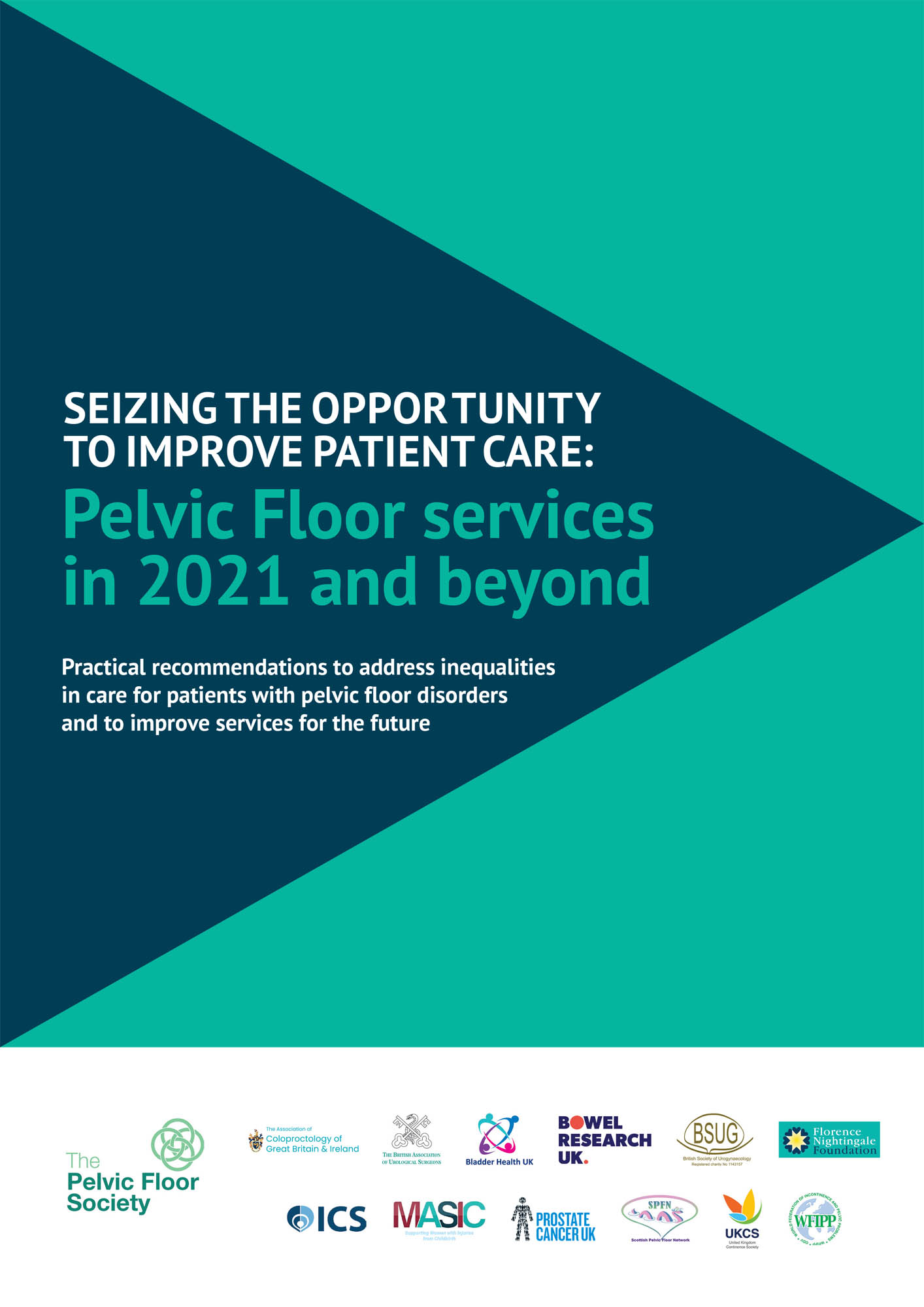

B
How we can use technology to improve patient care
Nikki Cotterill, Julie Cornish, Tatenda Marunda, Michael Powar
Technology offers a range of advantages and efficiencies. One of the more positive effects of the COVID-19 pandemic has been the widespread adoption of new technologies to support pelvic floor patients and ensure the continued provision of services – where there may have been resistance in the past, necessity has both increased the pace and broadened the scope of change. As part of a long-term ‘blended’ solution to improve the patient experience, technology can help us to deliver higher quality and more accessible care.
Patients with pelvic floor disorders, and especially those with incontinence issues, face a number of barriers to receiving medical treatment. Travelling to face-to-face appointments, particularly in the case of regional referrals, can be particularly difficult for these patients, who may be afraid to leave the house on a day-to-day basis. Pelvic floor departments are sometimes physically located under ‘women’s health’, providing an additional barrier for men, and the embarrassment associated with continence conditions may also discourage patients from attending in person. Nevertheless, physical examination at an early point in the pathway is required for most of these patients in order to diagnose and guide management.
Prior to the COVID-19 pandemic, patients often struggled to find information around self-management of their condition and psychological support, leading to a feeling of disempowerment and potentially negatively impacting adherence (Essery et al., 2017). This has been magnified during the COVID-19 era, as self-management has been the only option for many.


KEY POINTS
- Telemedicine, widely implemented during the peak of the COVID-19 crisis, is an important option for patients and offers many opportunities to break barriers; however, a blended approach (offering both virtual and in-person consultations) is likely to be needed
- Technology can further empower patients to take ownership of their condition, encouraging them to comply with prescribed regimens and offering opportunities to find support
- Patients often struggle to find resources online; online education and information are highly valuable for patients, but care must be taken to ensure accessibility and visibility
Reaching the potential of telemedicine
The shift towards telemedicine is widely seen as inevitable (Royal College of Surgeons, 2018), particularly given the changes necessitated and implemented during the COVID-19 pandemic (Clement et al., 2021). Feedback from patients on using a virtual clinic approach has been positive from many: it reduces time required for travelling and waiting for appointments, streamlines the process, and has allowed continued health provision despite the challenges of COVID-19. It also makes attendance easier for patients living in rural areas or for those with limited access to transportation (NHS England, 2019). The reduced requirement for travel is particularly beneficial for patients with continence issues, and so the option of virtual attendance should be made available in the long term. Communication via email or text messages could also offer options for appointments in satellite locations to improve accessibility for in-person consultations.
The sometimes-embarrassing nature of pelvic floor conditions does not seem to have hindered virtual appointments. In fact, a reduction in non-attendance has been observed in some centres compared with face-to-face visits. Online availability of information may encourage patients to present earlier or even to undertake self-management, both of which could lead to better outcomes with conservative treatments and a reduction in patients requiring surgery. Further, adequate adherence to conservative measures available in primary care is important to ensure these are truly exhausted by the time a patient reaches secondary care; patients may now be more likely to comply with these treatments, such as pelvic floor exercises.
Technology can provide further support to increase efficiencies, for example in obtaining an accurate patient history prior to consultations. Online questionnaires make it possible for patients to answer questions prior to their appointments, saving time during the consultation itself – and in the case of face-to-face consultations, minimising contact time, a desirable outcome in the face of a pandemic.

CASE STUDY:
ELECTRONIC QUESTIONNAIRES
Gathering a detailed patient history in advance can help to optimise efficiency during both virtual and in-person appointments. Electronic questionnaires are making this possible:
- The ePAQ questionnaire (ePAQ, 2016) from Sheffield is recommended by the Pelvic Floor Society, although payment of a licence fee is required
- The ICIQ questionnaires (ICIQ), while not yet available to complete on line, are in the process of becoming electronic – with the aim of ensuring availability online in 2021. The questionnaires are free to access for clinical services and small research projects, though larger funded research (such as NIHR), commercial use and industry-sponsored research incurs a fee
Patient consultations are not the only elements of care that can benefit from technology. Multidisciplinary team (MDT) meetings can also be conducted virtually, reducing the time commitment for participants and allowing people to join when they are unable to travel or located in different hospitals. Technology can be a key enabler for MDT working. Acceptance of virtual meetings has greatly increased since COVID-19 made this the norm, breaking down reluctance. In fact, in our experience, attendance at virtual MDTs has been improved over previous in-person meetings.
While virtual consultations are a valuable option, they are not suitable for everyone and risk excluding some members of society, for example, through digital exclusion and those with communication difficulties – telemedicine cannot be a one-size-fits-all solution (Clement et al., 2021). It is important that any changes in approach do not exacerbate existing health inequalities (NHS England, 2019). As the first wave of COVID-19 lifted, some patients were quick to request face-to-face consultations again. Further, there are situations where face-to-face appointments are necessary. Examination and assessment are limited in a virtual consultation, and nonverbal cues can be harder to pick up. Communication with patients who require translation services may also be more challenging. Performing a physical examination is essential for pelvic organ prolapse even if further diagnostic tests are planned. However, in some instances (for example, rectal prolapse), the greater adoption of digital self-photography and sharing thereof has reduced the problem of trying to reproduce a prolapse in clinic at the time of examination – though challenges relating to secure electronic sharing of potentially sensitive images must be considered, particularly when treating children.
Where virtual consultations are carried out, it is important to adhere rigorously to recognised treatment algorithms: clinicians will need to resist the temptation to over-investigate to compensate for not seeing their patients in person. As virtual consultations become a more frequent part of medical care, it will be important to incorporate these aspects into training (Clement et al., 2021): trainees should be involved in virtual consultations, to help them to appreciate the nuances of this type of review.


CASE STUDY: BLENDING THE VIRTUAL
AND PHYSICAL
At St Mark’s Hospital in London, face-to-face appointments are being reintroduced for initial and final appointments in order to provide reassurance and the opportunity for a physical assessment. Virtual consultations are available to patients for appointments in between.
Biofeedback sessions are being conducted with a mix of face-to-face and telephone consultations. Patient feedback on the approach has so far been positive, with most patients (of 40 surveyed) agreeing they were satisfied. Comments included: “Very good, having time to talk helped me understand my issues. Wonderful service” and “Excellent explanation, very helpful. Now [I] can manage better than before”, although some patients have struggled with appointment changes during lockdown.

CASE STUDY: AWARD-WINNING
VIRTUAL VISITS
London North-West University Healthcare NHS Trust responded to the onset of the COVID-19 pandemic by rapidly developing software to enable communication between patients and their loved ones, as well as between stretched and often locked-down NHS staff. The open-source software allowed video calls from anywhere in the hospital wards to anywhere in the world, was free to use and collected very little personal data, avoiding privacy of information governance issues. In November 2020, the project was awarded Best Healthcare Project of the Year at the UK IT Awards.
More information about this project is available at https://www.youtube.com/watch?v=VdLUHccMkzw&feature=emb_title.
Empowering patients to own their care
Patient empowerment is particularly important post COVID-19, reducing the number of unnecessary outpatient appointments but maintaining the patient’s ability to come into the hospital or clinic when needed, as well as enabling patient-initiated follow-up. Providing information and support online can help to achieve these goals, with better-informed patients better able to undertake self-management.
Some centres are going one step further and providing mobile applications, which offer the added benefit of outcomes data collection – particularly valuable for pelvic floor care, where data are few and far between. These data can then be fed back into services to make further improvements, supporting the global movement towards personalised medicine (Royal College of Surgeons, 2018). Such technology may also empower seldom-heard patient groups to have their voices heard more.


“[In the future,] greater access to and sharing of data, widespread availability of new technologies and remote support of experts may reduce inequalities and variation in treatment outcomes between different hospitals”
Royal College of Surgeons, 2018. Future of Surgery
Cost can be a barrier to implementation, particularly with new technology. Partnerships with industry, as seen in Cardiff with the ‘Living with…’ platform, can provide a short-term opportunity to introduce digital innovations, but it is also important to consider the savings and improvements that can be made in the long term. Continence will need to be considered more within spending priorities – this under-recognised patient group deserves, and needs, more investment.


CASE STUDY: VIRTUAL PATIENT SUPPORT
In Oxford, patient support groups were initially set up on a face-to-face basis with nurses present, in order to allow patients to discuss their concerns and receive advice and support from their peers as well as medical professionals. As a result of COVID-19 restrictions, these meetings have been transitioned successfully to an online meeting platform.
While some patients find it more challenging to build trust with strangers over a screen, others have benefited from the psychological distance and may find it easier to share their feelings. Thanks to the support groups, patients have reported feeling less lonely while awaiting procedures.

CASE STUDY: ‘LIVING WITH…’ PLATFORM
The ‘Squeezy’ app is supported by the ‘Living with…’ platform (https://www.livingwith.health/) and is currently in use in Cardiff, in collaboration with industry. Once logged in to the app, patients can complete baseline data and record the exercises they have undertaken. Their clinicians can review these data, improving their understanding of patient adherence as well as recording outcomes data at prescribed intervals. The app also allows clinicians to share contact details and appointment information, as well as links to learning resources. While they do not state the number of patients surveyed, the developers report that 90% of patients increased their adherence to exercise regimens after starting to use the app, with 78% noticing an improvement in their condition.
Breaking barriers to learning with remote education
As part of patient empowerment, it is important to ensure patients are informed. Webinars and online courses can be useful, though care needs to be taken to ensure that content is evidence-led, relevant and pitched at the right level. Webinars can be hosted on social media or on mobile applications as well as on purpose-built websites to improve visibility. Whatever the platform, signposts to charities, patient information websites and online support groups (whether UK-based or international; see Appendix) are important to include, as patients often struggle to find resources online. Use of patient-appropriate language and search engine optimisation skills may improve accessibility. A nationally supported continence promotion app, which aims to address this need, is in development and will be included in the NHS apps library.
Finally, technology can also help to improve education among HCPs. Owing to the necessity of online training during COVID-19, health professionals are now more widely accepting of this approach. An example is a certified e-learning programme for catheter training successfully rolled out in Wales. In addition, midwives have access to a peri-partum pelvic floor exercises e-module on the RCM i-learn platform, the result of a collaboration between the Chartered Society of Physiotherapy and the RCM, which was written and updated in 2020 by POGP. This approach provides an opportunity to engage more with HCPs’ education on the pelvic floor and to reach greater numbers, ultimately improving outcomes for patients.


CASE STUDY: ONLINE LEARNING
FOR HCPS
FutureLearn is hosting a number of online training modules for HCPs, including a module on continence promotion and management of bladder and bowel dysfunction (FutureLearn, 2020). This module was developed by the Association for Continence Advice and has had a positive reception from users, with an average rating of 4.9 out of 5 from 20 reviews at the time of writing.
This module is available at https://www.futurelearn.com/courses/understanding-continence-promotion/1
REFERENCES
Clement KD, et al., 2021. Communication tools in the COVID-19 era and beyond which can optimise professional practice and patient care. BMJ Innov 7:217–223.
ePAQ, 2016. A case for ePAQ-PF. Available at: http://epaq.co.uk/Home/GandO (last accessed September 2020).
Essery R, et al., 2017. Predictors of adherence to home-based physical therapies: a systematic review.Disabil Rehabil 39(6):519–534.
FutureLearn, 2020. Understanding Continence Promotion: Effective Management of Bladder and Bowel Dysfunction in Adults. Available at: https://www.futurelearn.com/courses/understanding-continence-promotion/1 (last accessed October 2020).
ICIQ. Modules. Available at: https://iciq.net/modules (last accessed September 2020).
Living With. Evidence: Pelvic Health. Available at: https://www.livingwith.health/evidence/pelvic-health/ (last accessed September 2020).
NHS England, 2019. The NHS Long-Term Plan: Equality and Health Inequalities Impact Assessment. Available at: https://www.england.nhs.uk/publication/the-nhs-long-term-plan-equality-and-health-inequalities-impact-assessment/ (last accessed April 2021).
Royal College of Surgeons, 2018. Future of Surgery. Available at: https://futureofsurgery.rcseng.ac.uk/ (last accessed September 2020).
